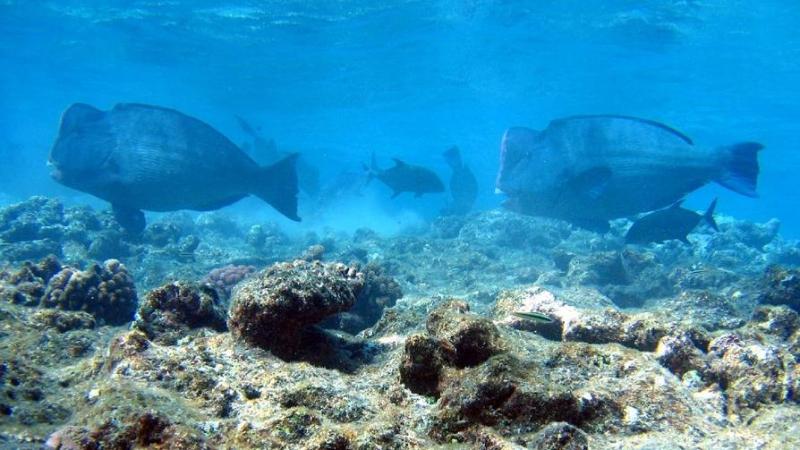
Image Credit: © Richard Ling via Flickr, [CC BY-SA 2]
Corals, fascinating sea creatures that come in myriad colours, add life to the sombre ocean depths by attracting diverse fish of vibrant hues. However, in recent decades, coral reefs across the world are threatened by bleaching—the expulsion of symbiotic algae that grow on these corals—due to global warming. The decline in healthy coral reefs results in dwindling fish numbers, including those that help in the growth of corals and maintain the health of the reef ecosystem. One such fish is the Bumphead parrotfish, Bolbometopon muricatum, found in the reefs of the Indian and Pacific Ocean.
In a recent study, researchers from two Bengaluru-based institutes—the Wildlife Conservation Society (WCS) and Ashoka Trust for Research in Ecology and the Environment (ATREE), have studied the distribution and the impact of protected marine areas on Bumphead parrotfish in the Andaman and Nicobar Islands. After months of data collection by scuba diving and capturing underwater photographs of the seafloor, their findings have now been published in the journal Oryx. The study was funded by WCS and the Ravi Sankaran Inlaks Fellowship Program.
“Besides gliding over the colourful coral reefs on several occasions, we were lucky to sight a dugong near 'While-cliff' island in North Andaman. The dugong is a state animal of the Andaman and Nicobar Islands and their sightings are rare”, recollects Dr Vardhan Patankar from WCS and an author of the study, talking about their expedition.
Bolbometopon muricatum feeds on sea plants and corals and helps in their maintenance, propagation and growth. It is classified as 'vulnerable' by the International Union for Conservation of Nature (IUCN). In India, it is found in reefs along the Gulf of Mannar, up to Lakshadweep, and in the Andaman and Nicobar Islands. However, little is known about its distribution and conservation status in the wake of coral bleaching and tsunamis. In this study, the researchers have tried to understand how the distribution of these fish change in response to such events.
"Bumphead parrotfish depend on the live coral cover as they munch on healthy corals. In 2016, almost 50 % of corals were bleached in the Andaman Islands. While we don't have quantitative data on how bleaching impacted the Bumphead parrotfish movement, it's very likely that the parrotfish abandoned the bleached area and moved to another healthy patch of corals", explains Dr Patankar.
As a first step, the researchers surveyed numerous sites in the Andaman and Nicobar Islands to understand the types of corals present here, other resources in the reef and the geographical conditions. They also calculated the abundance of B. muricatum through visual encounters and census at each site. They then used underwater photographs to record the features of the sea floor, such as the live coral cover, algae, sand, rubble and soft coral.
The researchers sighted a total of 59 individuals of B. muricatum at the surveyed sites, with the highest abundance recorded in South Andaman and lowest in North Andaman. They also found that Rutland Island in South Andaman is a haven for live coral with the largest cover, while Excelsior Island has the lowest live coral cover. The highest algal cover was present at Smith Island in North Andaman and lowest at the Katchal, West, Redskin, Kondul and Menchal islands. Other islands had an intermediate level of live coral cover.
The study also interviewed the local fishing communities in the villages of the islands and gathered information on the perception of the fisherfolk towards B. muricatum present in their waters, the types of fishing gear used, the different fish captured and encountered and the time of fishing. They found that although most of them were aware of the presence of the fish in their waters, the catch was always incidental rather than targeted. Many of them used more than one type of fishing gear, including hook and line, handheld spears, harpoons and gill nets, to diversify their catch. Hook and line was the most common fishing gear.
Interestingly, the researchers found that live coral and algal cover significantly influenced the distribution and abundance of B. muricatum. In marine protected areas, where fishing is restricted, these fish thrived. Although the high density of live coral and algae support the rich abundance of B. muricatum, overfishing could result in their decline, they claim.
In countries like the USA and Palau, fishing near the coral islands and export of Bumphead parrotfish are banned to conserve their population. India, on the other hand, is yet to take action in this regard. "While there is a global drive to conserve this species, it is not included in the Indian Wildlife Protection Act, and presently, no management strategy or plan is active for their protection", rues Dr Patankar, adding that an environmental assessment of these fish in this region is pending.
"We plan to conduct a regional IUCN assessment for the species and lobby the Ministry of Environment and Forests to provide legal protection to the species", he concludes.
This article has been run past the researchers, whose work is covered, to ensure accuracy.






